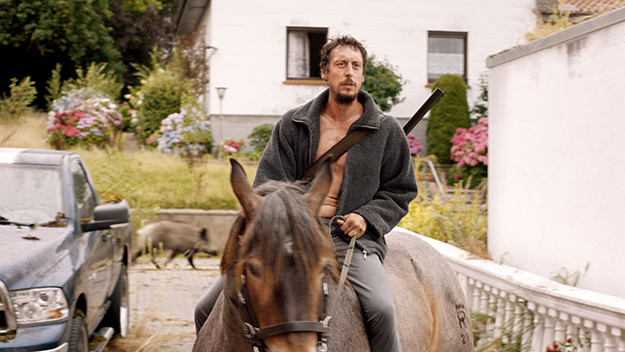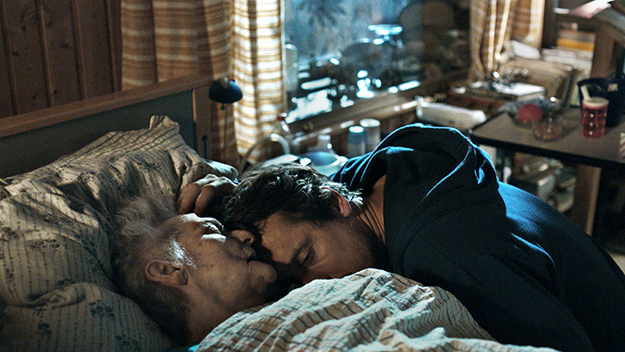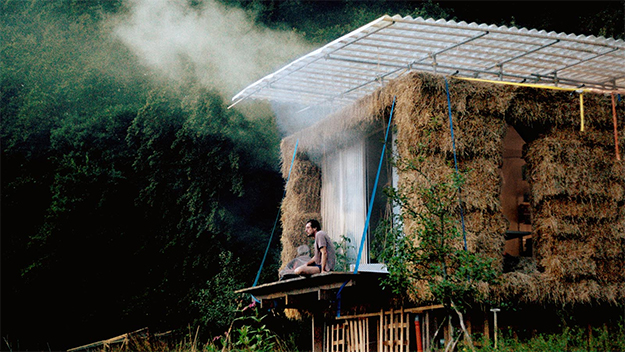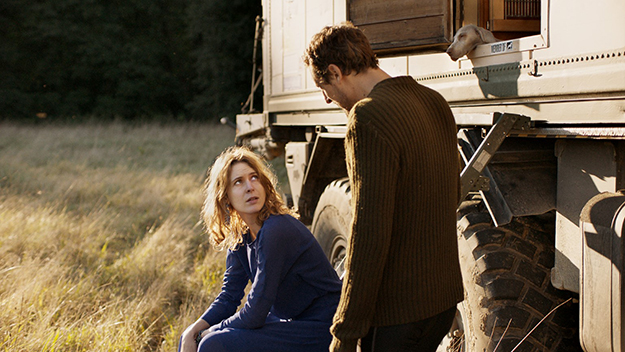Film of the Week: In My Room

Images from In My Room (Ulrich Köhler, 2018)
The Apocalypse in cinema doesn’t need to be upper-case Apocalyptic. The alternative to “Behold the devastation!” can simply be a pensive, “Hm, strange—where’s everybody gone?” There’s the Roland Emmerich approach—and then there’s Ulrich Köhler. In My Room, from the German director of 2011’s Sleeping Sickness, is an unusually low-key vision of the end of the world—or at least, the end of someone’s world. It begins in a register of mundane everyday realism, vaults suddenly into an uncanny vision of the extraordinary, and then shifts back into a different mode of realism, showing its protagonist getting on with life in a quiet, pragmatic fashion.
This depiction of future-tense survival as a plain, pressing job of work has long been a trope of post-apocalypse drama, and the business of dealing with the challenge of a new future is not itself the most remarkable thing about In My Room. Arguably what’s most striking about the film is the way that Köhler confidently shifts, and shifts again, from one register to another: the way that one regime of life turns suddenly and unexpectedly, but altogether non-spectacularly, into the next.
For something like the first 35 minutes, Köhler’s film seems like a very routine piece of lifestyle realism—the story of a middle-aged man adrift in an uneventful, unremarkable dead end of a life. Berlin dweller Armin—played by the sallow-faced, lugubrious Hans Löw—is a TV news cameraman but not, he later explains to his family, the sort that gets to film Angela Merkel. Which is just as well: at the very start of the film, we see footage he has just shot of various officials, as he realizes he has somehow managed not to film the most important part of their statements. Not surprisingly, his life is something of a mess. In the editing suite, he doesn’t even have small change to buy coffee for himself and a colleague. He’s later seen at a club, sticking out like a sore thumb among the techno revelers, then in his apartment with a much younger woman who has come home with him, but who soon changes her mind about sticking around.

After walking through a political demonstration—he’s making a phone call, but you sense that he wouldn’t be very aware of the crowd anyway—Armin drives to the country, to his divorced father’s house, where his elderly grandmother is lying on her deathbed. The two men keep a quiet vigil, then are joined by his dad’s girlfriend. When the old woman dies, Armin and his father calmly, respectfully put her false teeth back in so that she can peacefully lie in state.
We also meet the next door neighbor, a dog owner who enjoys hunting. And Armin also drops in at his mother’s house, but she has a choir meeting in progress, so he leaves. Köhler sets us up to take an interest in all these people—only for them suddenly to be erased, as if he had simply hit the delete key while writing the script. I don’t know whether the British science fiction writer John Wyndham (The Day of the Triffids) ever had a major following in Germany, but the film’s setup is pure Wyndham: we’re introduced to a world we know, sketched in all its unexceptional familiarity in acute detail, before the rug of normality is yanked abruptly from under our feet.
In My Room performs this trick with utmost subtlety: after a night sleeping in his car, Armin wakes to find that everyone in the world has apparently disappeared. Köhler introduces us to the nightmare with concise, informative strokes, but also some poetic ones. Dropping in at a garage, Armin finds the place deserted: outside, a motorbike stands with its motor still turning over, while a driverless car is still attached to the petrol pump. While these are banal images, others seem closer to the more spectacular language of the disaster movie—more motorbikes lie abandoned on a motorway, as if their riders had suddenly vaporized in mid-journey. Other images have more of a poetic ring: a riverboat that the night before was laden with partygoers now floats aimlessly like driftwood.
Back at his father’s house, Armin decides to draw a line between the world he has known and this new state of things. His dead grandmother still lies in bed, as if ready for a state funeral; for some reason, the dead stay where they are, and only the living have vanished, while animals, like the distraught dog next door, stay where they are. Armin strips naked, having liberally puked on himself the night before (the film has a bracingly anti-heroic tone), builds a bonfire under Grandma’s bed, and burns the house down before leaving. That he builds the pyre out of sheet music seems to signal his farewell to the culture of a dead world.

The film takes its title from a Brian Wilson number—his most poignantly melancholic—but the song that might come to mind at this point is Steely Dan’s “King of the World,” about being a lone survivor in a doomed world (“There’s no need to hide / Taking things the easy way / If I stay inside / I might live till Saturday”). For a brief moment, Armin does act like king of the world, commandeering a streamlined police car and racing perilously along the highway, through the chicanes formed by buildings and abandoned vehicles (seen in long-take POV, as if we’re looking through the windscreen of a Le Mans racer).
The shift into the new world proper is sudden but low-key, an effortless shift. Before we know it, Armin isn’t racing but proceeding with careful deliberation—using a horse to plough a field. We don’t know how much time has passed, but Armin has become a sort of inland Robinson Crusoe, tending the land, getting to grips with an energy-generating water wheel, disentangling a goat from a thicket. He has moved into an extraordinary farmhouse that resembles a giant haystack—the absolute union of ruralism and technology—and has himself evolved to fit this new world that is keeping him alive. By contrast with the flabby, morose figure seen earlier, he’s leaner, and apparently happier.
It turns out, however, that Armin isn’t quite alone. Someone’s dog jumps out at him one day, causing him to fall off his horse and into a river; he’s wounded, but wakes to find that someone has been tending him in secret. It’s a young woman named Kirsi (Italian actress Elena Radonicich); she’s a more nomadic survivor, who’s been driving around in the company of her dog. At this point, the film takes what some will feel is a predictable turn, as the pair become lovers. It feels like an altogether generic option to pair an only moderately appealing male protagonist with a female counterpart who’s strikingly more attractive than he is; still, we can surely buy the idea of the two pairing off, for sexual release, emotional support and to get through those winter nights. The film does dangle the prospect of a “New Adam and Eve” scenario in front of us, and apparently it occurs to Armin—but Kirsi has very different ideas.

The time they spend together is evocatively depicted. There’s a visit to an desolate sarcophagus of a video store, now covered on the outside with the cascading foliage that has reclaimed the world: inside, the duo wryly consider the specialist porn on offer, while Kirsi tells Armin how much she fancies Ryan Gosling. While Kirsi goes hunting, Armin gets to grips with the waterwheel, which powers the house’s lights, music and even a laptop: it’s on that screen that Armin watches The Bridges of Madison County, possibly the last movie left extant. In a gas station forecourt, the once lugubrious Armin at last lets rip with his emotions, euphorically capering to the boom of Tiësto’s techno version of Barber’s “Adagio For Strings.”
Köhler bypasses at least some of the expected gender dynamics between Kirsi and Armin: while Armin apparently hasn’t lived a great deal, she has stories of surviving in the Syrian desert; he has stayed quietly on the farm, while she has driven around in her tank-like armored car, as if she has been inhabiting a world much more like Mad Max’s future than Armin’s. She is not presented as an idealized action heroine, but as a woman of tenacity, vulnerability, and impatience, perhaps more naturally independent than Armin; he has become independent, a true loner, only recently, whereas we sense that she may have been one all along. She certainly proves the more independent of the pair, right up to the final shot, an elegant long take that works to an effect both tender and desolate.
While the film ends with the Pet Shop Boys’ mournful ballad “Last Night,” we never hear that Beach Boys song the film is named after. The title plants a seed of uncertainty that gives a tense extra layer to the matter-of-factness of the events shown. Maybe the room alluded to is the consciousness of Armin, who is as much a loner in the world as the song’s first-person teenage hermit. Maybe the disappearance of the world’s population is implicitly an erasure wished for by Armin, who no longer needs the people he has known, and who might as well be alone in the world as not. There are no logical answers in a film where the extraordinary just happens, and that makes In My Room less a disaster movie than a parable, an extremely moving one, and all the more resonant for being so simple. Unreal as the situation is, Köhler makes Armin and Kirsi very real: at the end, we wish them well, hope they live long, and hope they at least find some more movies out there that they can watch.
Jonathan Romney is a contributing editor to Film Comment and writes its Film of the Week column. He is a member of the London Film Critics Circle.







